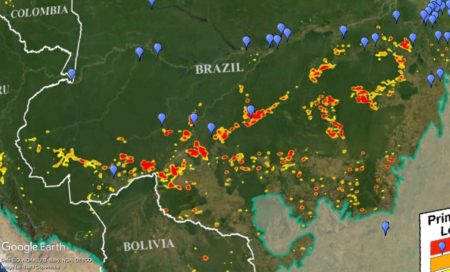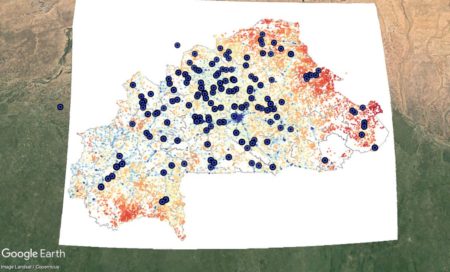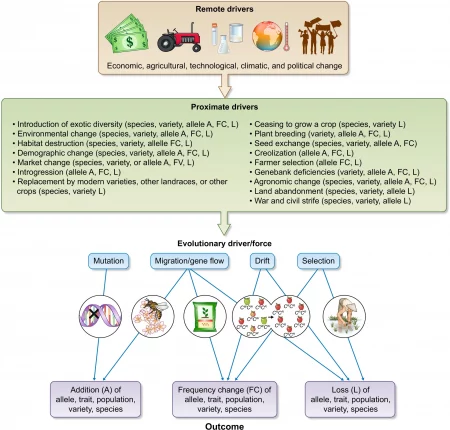What’s that you say? You don’t have time to slog through dozens of pages of text, diagrams, tables and supplementary materials on genetic erosion? Ok, then, have you got time to listen to lead author Colin Khoury talk about the paper in question for an hour or so? Of course you do. This is just the latest of a great series of webinar, see all the others on the Genebank Platform page.
Questioning maps
As regular readers know all too well, I can’t resist a map mashup. So when I saw the latest data on deforestation in the Amazon, I fired up MapWarper and GoogleEarth and got to work.
And here’s a look at how recent deforestation in Brazil relates to the localities of past cassava collecting, at least as far as Genesys knows about it.
Now, I don’t know in what way deforestation (and associated disruptions) relates to loss of cassava diversity, but there’s a chance that it might. Could make an interesting PhD project for someone.
Anyway, encouraged by my pretty result, and remembering that I wanted to do something with some shiny new maps I had heard about, I next mashed up sorghum accessions and poverty in Burkina Faso. Here’s what I got.
What’s going on? Why are there relatively fewer sorghum accessions where poverty is higher (more red)? Are those places just harder to reach? Or do people there really grow less sorghum.
Again, I don’t know. But I think it would be interesting to find out.
All speculation welcome in the comments.
Brainfood: RICA, AEGIS, CWR, Agrosavia, DSI, CRISPR, Tradition, SNS, Stability, Birds, Sparing, Genetic erosion
- RICA: A rice crop calendar for Asia based on MODIS multi year data. RiceAtlas validated. Still trying to figure out how to mash it up with genebank accession locality data though. Any GIS geniuses out there to help me?
- AEGIS, the Virtual European Genebank: Why It Is Such a Good Idea, Why It Is Not Working and How It Could Be Improved. Certify genebanks, that’s how.
- Reap the crop wild relatives for breeding future crops. Needs good data and certified genebanks. Plus gene editing.
- Opportunities and Challenges to Improve a Public Research Program in Plant Breeding and Enhance Underutilized Plant Genetic Resources in the Tropics. Needs better social networking. Plus better data and certified genebanks, presumably.
- From seed to sequence: Dematerialization and the battle to (re)define genetic resources. Ah yes, data.
- Current Advancements and Limitations of Gene Editing in Orphan Crops. Ah yes, gene editing.
- Revitalizing Traditional Agricultural Practices: Conscious Efforts to Create a More Satisfying Culture. Meanwhile, in Sweden…
- Sacred natural sites and biodiversity conservation: a systematic review. Of course sacred sites are good for biodiversity. But it’s always good to have the data.
- Global relationships between crop diversity and nutritional stability. Sacred sites are not enough, alas.
- Preserving local biodiversity through crop diversification. Crop diversity is even good for birds…
- Concentrating vs. spreading our footprint: how to meet humanity’s needs at least cost to nature. …but, overall intensification of agriculture coupled with sparing land for conservation (maybe even in sacred sites) is the best approach for wildlife. And humanity, for that matter. So, back to needing better data from certified genebanks, so we can get that intensification done, right?
- Quantifying the scale of genetic diversity extinction in the Anthropocene. Right!
“Almost 80%” is the new 75%
Almost eighteen months in the making, or 80 years, depending on how you look at it, yesterday saw the publication of a gargantuan review of the literature on crop genetic erosion. 1
The team reviewed hundreds of primary literature sources published over the last 80 years that examine potential crop diversity loss, also called “genetic erosion”. The global collaborative effort found that 95% of all studies reported diversity change, and almost 80% found evidence of loss.
The most interesting (but, to be fair, unsurprising) thing to me though, apart from our evidence base still being fairly limited for many crops and regions, was the variation in the magnitude of loss, which depended hugely “on species, taxonomic and geographic scale, and region, as well as analytical approach.”
What’s to be done? Well, I won’t kid you, it won’t be easy.
Reversing the trajectory of crop genetic erosion requires more profound change – no less than reorganizing global agriculture, and food systems, and even the human societies they nourish, to become diversity-supportive processes… Crop diversity must be valued not only as a genetic resource to be exploited, but just as much for its cultural and ecological values… This implies a (re)integration of species, varietal and genetic diversity into agricultural systems, both temporally and spatially, as well as the (re)establishment of local autonomy and markets supporting the processes that foster the ongoing evolution of this diversity.
So let’s roll up our sleeves, yes? As, for example 2, Vijay Jardhari and his friends have done in Uttarakhand. And Vivien Sansour is doing in Palestine. And Charity Lanoi is doing in Kenya. And Hamidou Falalou and his ICRISAT colleagues are doing in Chad. And as the Svalbard Global Seed Vault hopes to do in the next few months up in the Arctic.
Because, as a nicely complementary paper by Moises Exposito-Alonso and co-authors also pointed out in the past few days, though referring to 19 wild plant and animal species, “over 10% of genetic diversity may be extinct” already.
https://twitter.com/mexpositoalonso/status/1449158576975482880
Legendary ethnobotanist bags award
Congratulations to my friend Pablo Eyzaguirre for receiving the Distinguished Economic Botanist award for 2021 from the Society of Economic Botany. It looks like his wonderful talk describing a career dedicated to exploring the connection between agricultural biodiversity and human wellbeing in all its forms was recorded. I’m not sure whether it will be available to all, but I really hope so, as it would inspire many, as Pablo did me many years ago.


